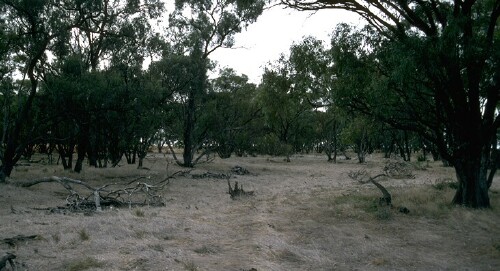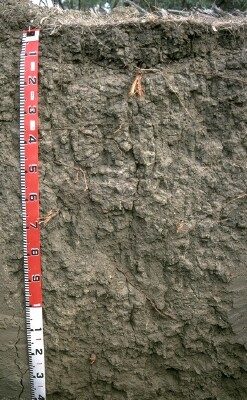LP3
| Location: Leaghur | Australian Soil Classification: |
| General Landscape Description: Flat plain. Original vegetation included Black Box. | Local Name: Boort Clay |
 LP03 Landscape |
Surface Soil
| A1 | 0-15 cm | Dark greyish brown (10YR4/2); medium clay; self-mulching and cracking surface condition; strong prismatic, breaking down to strong fine blocky structure; strong consistence dry; pH 7.8; sharp and wavy change to: |  LP03 Profile |
Subsoil | |||
| B21 | 15-50 cm | Dark greyish brown (2.5Y4/2); heavy clay; strong coarse prismatic structure; strong consistence dry; contains a few (2-10%) fine carbonate nodules; pH 8.8; gradual change to: | |
| B22 | 50-90 cm | Greyish brown (2.5Y5/2); heavy clay; strong coarse prismatic structure; very strong consistence dry; contains a few (10%) hard carbonate nodules, as well as some soft carbonate and black inclusions; pH 9.1; gradual change to: | |
| B23 | 90+ cm | Light yellowish brown (2.5Y6/4); heavy clay; strong coarse prismatic, breaking down to fine angular blocky structure; rigid consistence dry; contains a few (2-10%) hard carbonate nodules; pH 9.6. | |
Key Profile Features
- High clay content throughout profile.
- Self-mulching and cracking surface condition.
- Accumulation of carbonates in the subsoil.
- Vertic properties (i.e. cracking surface condition).
Key Profile Characteristics
 |
Management Considerations:
Whole Profile
- A very positive feature of this profile is that it has a very high inherent fertility throughout which is benefical to plant growth.
Surface (A) Horizon
- The surface soil is self-mulching which provides a good seed bed that is friable and easily worked. Fine roots were apparent within the surface soil.
- When the soil is dry, heavy rains will move down soil cracks. This rapid recharge can be valuable for the survival of plants near wilting. When wet, the soil will swell and further infiltration will be relatively slow.
- Tillage of cracking clay soils should be avoided if the soil is wet (i.e. wetter than the plastic limit). At such a moisture condition, excessive tillage, trafficking or overstocking can result in structural degradation (e.g. compaction, smearing) occurring. Ideally, tillage should take place on clay soils such as these when the soil is drier than the plastic limit, down to at least the tillage depth.
- The surface (A1) horizon is non-sodic without dispersion after immersion in water. This is probably due to the high exchangeable calcium levels. However, there is strong dispersion after remoulding the soil and immersing it in water. This indicates that some structural degradation may occur if cultivation occurs when the soil is wet.
- The levels of organic carbon measured at the pit site is low (this may or may not be representative of the whole paddock).
- The levels of total nitrogen measured at this pit site is moderate. However, this is best assessed by taking a bulked sample from across the paddock.
Subsoil (B) Horizons
- The strongly alkaline subsoil suggests that some nutrients (e.g. iron, manganese, zinc, copper) may be poorly available to plants and that deficiencies are likely to occur. Deficiencies can be determined by plant tissue analysis.
- The subsoil is densely and coarsely structured and after 70 cm becomes strongly sodic with a very low exchangeable calcium to magnesium ratio (0.2). Dispersion occurs as a result and root and water movement will be restricted.
- The levels of exchangeable magnesium are high and could also be toxic to plant growth.
- The subsoil displays vertic properties which indicates that significant shrinking and swelling occurs with wetting and drying cycles. This may disturb the roots of some plant species and has engineering implications (eg. disturbance to building foundations and fence lines).
- This soil type is similar to Murrabit Clay. It is self-mulching and has a major flood every 10 years and a minor flood ever five years.
- The soil is massive and has gilgai (i.e. shrinking and swelling). Accordingly, water movement down the profile is not very good. Organic matter and gypsum application would be beneficial to this soil and urea would greatly increase the structure.
- The soil requires three inches of rainfall for water holding capacity.


